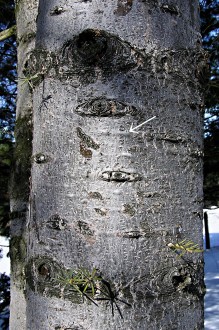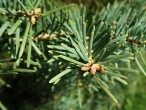(Abies concolor Lindl. et Gord.)
Habitus
- tree 30-40 m high
- crown dense when young, conical, later cylindrical
- branches in the whorls deviate from the trunk almost horizontally
- bark is light gray
- resin blisters on the bark!
- ross is brownish gray, irregularly cracked, rough
Buds
- buds are 3 - 5 x 2 - 3 mm in size, blunt terminal
- wrapping scales are yellowish, resinous
Leaves (assimilation organs)
- assimilation organs are needle-shaped, 50 - 80 x 2 - 2.5 mm in size, bluntly pointed, flat, grayish green, dull and the same color on both sides, sickle-shaped
- last 4 - 6 years
Flowers
- monoecious wood, blooms IV - V
- male (♂) cones are oblong-ovoid, grow from the underside of last year's shoots
- female (♀) cones are cylindrical to spindle-shaped, 30 - 50 x 10 mm in size, upright, grow on the upper side of the shoots in the 2 - 3 highest whorls of the crown
Fruits – seeds
- the fruit is a cone 70 - 120 x 35 - 50 mm large, cylindrical, green before ripening, brown after ripening, ripens in October (falls apart after ripening - similar to the white fir)
Extension
- in the territory of Slovakia it occurs only as a cultivated species
- originally it is widespread in the western part of the North American continent from southern Oregon in the north to northern Mexico in the south
- in the Rocky Mountains it grows in a range of 2,000-3,000 m
Ecology
- semi-shade tree, undemanding to moisture, resistant to low temperatures, tolerates the urban environment well
Significance
- in greening in parks, gardens as a decorative tree – mostly with long needles, several forms are known - columnar, drooping, spherical with different colored needles













